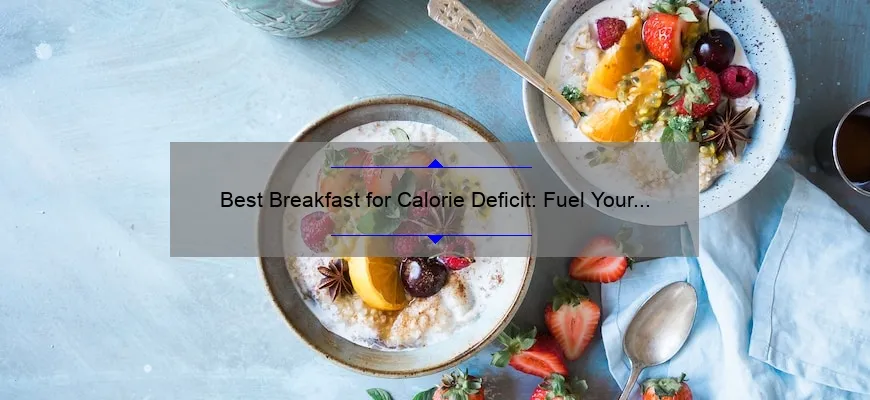Short answer: Best Breakfast for Calorie Deficit
The best breakfast options for a calorie deficit are those that are low in calories but high in nutrients. Some top choices include oatmeal with fruits, Greek yogurt topped with berries, spinach omelet, or whole grain toast with avocado. These options keep you full while providing essential vitamins and minerals.
What is the Best Breakfast for Calorie Deficit?
When it comes to achieving a calorie deficit, breakfast plays a crucial role in setting the tone for the rest of your day. Starting off with a nutrient-dense and satisfying meal not only ensures you kickstart your metabolism but also helps you stave off hunger pangs and cravings throughout the day. So, what exactly constitutes the best breakfast for a calorie deficit? Let’s dive in to find out!
First and foremost, it’s important to emphasize that everyone’s dietary needs and preferences are unique. However, there are a few general guidelines that can steer you towards making smart choices for your morning meal.
To begin with, protein is king! Including a good source of protein at breakfast provides essential amino acids that support muscle growth, repair, and maintenance. It also increases satiety levels, keeping you feeling fuller for longer and reducing the likelihood of mindless snacking later on. Options such as eggs (which are an excellent source of high-quality protein) or Greek yogurt (packed with both protein and probiotics) make unbeatable breakfast choices.
In addition to protein, incorporating healthy fats into your morning routine can do wonders for curbing unnecessary calorie consumption throughout the day. Avocado slices on whole-grain toast or nut butter spread on an apple are scrumptious ways to get those essential fats while staying within your calorie goals.
Fiber should also deserve special attention when crafting your ideal calorie-deficit breakfast. High-fiber foods not only contribute to better digestion but also promote feelings of fullness and overall satisfaction. Incorporating fruits like berries or bananas into oatmeal or enjoying a fiber-rich slice of whole-grain bread will help keep you feeling satisfied until lunchtime.
Now let’s add some pizzazz! Just because we’re talking about making healthy choices doesn’t mean our taste buds have to suffer. Get creative with herbs and spices instead of relying heavily on salt or sugar-laden condiments. Think cinnamon sprinkled on top of your Greek yogurt or a sprinkle of paprika on your scrambled eggs. These simple additions can kickstart your metabolism, enhance the flavors of your breakfast, and add a dash of excitement to your morning routine.
Finally, never underestimate the power of hydration. Don’t forget to accompany your well-balanced breakfast with a refreshing glass of water or a cup of green tea. Adequate hydration not only aids digestion but also helps control cravings and supports optimal bodily functions.
In conclusion, the best breakfast for a calorie deficit is one that combines protein, healthy fats, fiber, and an element of satisfaction for your taste buds. Remember to personalize it according to your preferences and dietary restrictions while keeping an eye on portion sizes. By starting off each day with a satisfying and nutrient-dense meal, you’ll set yourself up for success in reaching your calorie deficit goals and maintaining a healthy lifestyle throughout the day. Enjoy!
Step-by-Step Guide to Creating the Ideal Breakfast for Calorie Deficit
Are you looking to shed a few pounds and achieve a calorie deficit? Well, you’re in luck because we have the ultimate step-by-step guide to creating the ideal breakfast that will kickstart your day and help you reach your weight loss goals. But here’s the best part – this breakfast is not only nutritious, but it’s also deliciously satisfying, making it easier for you to stick with your calorie deficit plan. So grab your fork and let’s get started!
Step 1: Choose a High-Protein Base
Protein is an essential macronutrient when it comes to weight loss. Not only does it help build and repair muscles, but it also keeps you feeling full for longer periods of time. Start by selecting a high-protein base for your breakfast such as eggs, Greek yogurt, or cottage cheese.
Step 2: Load Up on Fiber
Fiber is another vital component in a calorie-deficit diet as it aids in digestion and promotes feelings of satiety. Add some fiber-rich foods to your breakfast like whole grains (oats or whole wheat bread), fruits (berries or apples), or vegetables (spinach or kale). These ingredients will not only keep your tummy satisfied but also provide essential vitamins and minerals.
Step 3: Don’t Forget Healthy Fats
Contrary to popular belief, fats are not the enemy when it comes to losing weight. In fact, including healthy fats in your breakfast can actually enhance fat burn and help you stay on track with your calorie deficit goals. Opt for sources such as avocado slices, chia seeds, flaxseed oil, or nuts like almonds or walnuts.
Step 4: Balance Your Macronutrients
Achieving a well-balanced meal is crucial when creating the ideal breakfast for a calorie-deficit plan. Make sure to include all three macronutrients – protein, carbohydrates, and fats – in appropriate portions to keep your energy levels steady throughout the day. For example, a great combination could be scrambled eggs (protein), whole grain toast (carbohydrates), and avocado slices (healthy fats).
Step 5: Add Some Flavor
Who says healthy breakfasts have to be boring? A little creativity can go a long way, so don’t hesitate to add flavorful ingredients that elevate your meal. Experiment with herbs and spices like cilantro or paprika, incorporate low-calorie condiments such as hot sauce or salsa for an extra kick, or even sprinkle some cinnamon on your yogurt for added sweetness. Remember, eating well doesn’t mean compromising on taste!
Step 6: Portion Control
While it’s important to choose nutritious foods, portion control is equally vital in maintaining a calorie deficit. Be mindful of the quantities you’re consuming and consider using smaller plates or bowls to help control portion sizes visually. This practice will ensure you’re not unknowingly exceeding your target caloric intake.
Now that you have all the steps down pat, let’s put them into action! Here’s an example of an ideal calorie-deficit breakfast based on our guide:
– Scrambled eggs loaded with diced veggies like bell peppers and spinach (protein)
– A slice of whole-grain toast topped with mashed avocado and cherry tomatoes (carbohydrates + healthy fats)
– A side dish of Greek yogurt mixed with fresh berries and sprinkled with chia seeds (protein + fiber)
With this delicious breakfast, you’ll be nourishing your body while staying within your calorie deficit limit – a win-win situation!
Remember, a successful weight loss journey requires consistency and determination. So stick to your plan and make adjustments as necessary along the way. Before you know it, that ideal breakfast will become a daily ritual that helps propel you towards your fitness goals.
Now go ahead, create the perfect calorie-deficit breakfast and jumpstart your day!
FAQ: Answers to Your Burning Questions about the Best Breakfast for Calorie Deficit
Thank you for visiting our blog! Today, we are here to answer some burning questions about the best breakfast options for maintaining a calorie deficit. If you’ve been struggling with achieving your weight loss goals or simply want to make healthier choices in the morning, this FAQ is tailored just for you. So, let’s dive right in and enlighten you with professional, witty, and clever explanations!
Q: What exactly is a calorie deficit?
A: Ah, excellent question! A calorie deficit refers to consuming fewer calories than your body burns throughout the day. By creating this deficit, your body taps into stored fat reserves as an energy source. Ultimately, it results in weight loss. Breakfast provides a crucial opportunity to kickstart your metabolism and set the tone for the rest of the day.
Q: What should I consider when choosing a breakfast option for a calorie deficit?
A: When selecting your morning meal within a calorie deficit framework, keep three key factors in mind – nutritional value, satiety factor (how full it keeps you), and taste satisfaction. It’s equally important that your chosen breakfast aligns with your personal preferences because sticking to any routine requires motivation!
Q: Can’t I simply skip breakfast altogether if I’m trying to create a calorie deficit?
A: Skipping breakfast can be tempting but it may not be the wisest approach! Breakfast helps jumpstart your metabolism after an overnight fast and prevents excessive hunger later in the day, reducing the likelihood of overeating during subsequent meals. Instead of completely bypassing breakfast, choose nutrient-dense options that won’t sabotage your daily caloric intake.
Q: What are some nutritious yet low-calorie choices for breakfast?
A: You’re on fire with these inquiries! Here are some fantastic low-calorie options that pack quite the nutritional punch:
1. Scrambled Egg Whites with Veggies – Packed with protein and fiber while being light on calories.
2. Greek Yogurt with Berries – Rich in protein, probiotics, and antioxidants.
3. Oatmeal with Fresh Fruit – High in fiber and complex carbohydrates, keeping you full for hours.
Q: How can I make my breakfast more satisfying without increasing the calorie count?
A: Wondering how to level up your breakfast experience without tipping the scale? Here are some clever tricks:
1. Incorporate healthy fats like a spoonful of almond butter or a sprinkle of chia seeds to amp up flavor and satiety.
2. Use spices and herbs such as cinnamon or nutmeg to add depth and warm autumnal vibes!
3. Experiment with different cooking techniques such as poaching an egg instead of frying it – less oil but still delicious!
Remember, staying within your calorie deficit doesn’t mean compromising on taste or enjoyment. Get creative in the kitchen while making smart choices.
Q: Any other tips or advice for maintaining a calorie deficit through breakfast?
A: Certainly! Here are some bonus tips to help you conquer your breakfast journey:
1. Plan ahead – Prepare ingredients or even whole meals in advance to save time and ensure a nutritious start.
2. Hydrate wisely – Start your day by rehydrating your body with water instead of sugary beverages.
3. Mindful eating – Slow down and savor each bite, allowing yourself to appreciate the flavors and textures fully.
In conclusion, finding the best breakfast options for a calorie deficit requires thoughtfulness, creativity, and attention to nutritional balance. Whether it’s an egg-cellent scramble or a fruity oat-filled delight, there’s no shortage of palate-pleasing choices that won’t derail your weight loss efforts.
We hope this FAQ has answered all your burning questions about optimizing your morning meal! Remember, consistency is key when embarking on any health journey. By starting off right at breakfast, you’ll set yourself up for success throughout the rest of the day. Good luck and enjoy your nutritious, calorie-deficit breakfasts!
Top 5 Ingredients to Include in Your Breakfast for Effective Calorie Deficit
If you’re looking to shed some pounds and create an effective calorie deficit, then it’s crucial to start your day with a breakfast that will fuel both your body and weight loss goals. The right combination of ingredients can not only provide essential nutrients but also help rev up your metabolism, keeping you full and satisfied until your next meal. In this blog post, we’ll uncover the top 5 ingredients that you should include in your breakfast for an effective calorie deficit.
1. Protein Powerhouse: Kick-starting your morning with a protein-packed meal is essential for long-lasting satiety and muscle repair. Include lean proteins such as eggs, Greek yogurt, or cottage cheese in your breakfast routine. Not only will they keep you feeling full for hours, but they will also assist in building lean muscle mass which burns calories even at rest! So say goodbye to those mid-morning hunger pangs!
2. High-fiber Magic: Incorporating high-fiber foods into your breakfast can be a game-changer when it comes to achieving an effective calorie deficit. Foods like whole grain bread, oats, and chia seeds are excellent choices as they provide a steady release of carbohydrates throughout the morning, preventing spikes in blood sugar levels and ensuring sustained energy. Additionally, fiber plays a crucial role in digestion by promoting regular bowel movements, keeping bloating at bay.
3. Antioxidant Superstars: Adding fruits rich in antioxidants – think berries or citrus fruits -to your morning meal has numerous benefits beyond their exquisite taste. These colorful delights are packed with vitamins and minerals while being low in calories, making them perfect additions to support an effective calorie deficit strategy that won’t leave you feeling deprived.
4. Healthy Fats: Contrary to popular belief, fat is not always the enemy! Including healthy fats like avocado or nuts in your breakfast can actually aid weight loss efforts. These good fats take longer to digest than carbohydrates, helping us feel satiated for longer. They also enhance the absorption of fat-soluble vitamins, ensuring you get the maximum nutritional benefit from your meal.
5. Hydration Heroes: Don’t underestimate the power of hydration when it comes to weight loss! Starting your day with a glass of water infused with lemon or even sipping on green tea can help kick-start your metabolism and support effective calorie deficit by boosting calorie-burning processes in your body. Plus, staying hydrated throughout the day can prevent unnecessary snacking and keep you feeling refreshed.
Remember, creating an effective calorie deficit is not about deprivation or extreme measures; it’s about making smart choices that satisfy both our taste buds and weight loss goals. By incorporating these top 5 ingredients into your breakfast routine, you’ll set yourself up for success in achieving long-lasting results while enjoying a delicious morning meal that keeps those pesky cravings at bay. So go ahead and start your day off right with a breakfast that helps create an effective calorie deficit – it’s time to transform breakfast into your secret weapon!
Delicious Recipes to Try for the Best Breakfast while on a Caloric Deficit
Are you on a journey to shed those extra pounds or maintain a healthy lifestyle by being on a caloric deficit? Well, if breakfast is the most important meal of your day, then it’s crucial to make it not only nutritious but also scrumptious. We understand that finding delicious recipes while sticking to a caloric deficit can be challenging. But worry not, because we’ve got you covered! In this blog post, we present some delightful and mouthwatering breakfast ideas that won’t compromise your goals.
1. Egg-cellent Omelette: Start your day right with an omelette packed with protein and essential nutrients. Whip up three egg whites, mix in a handful of chopped vegetables like spinach, bell peppers, and tomatoes. Add some low-fat cheese for extra flavor and fold it into perfection. This hearty omelette will keep you feeling full without breaking the calorie bank.
2. Slimming Smoothie Bowl: A lusciously thick smoothie bowl is an ideal way to fuel yourself in the morning while keeping your calories in check. Combine one ripe banana, a handful of frozen berries, a scoop of protein powder, and some almond milk in a blender until smooth. Pour the vibrant mixture into a bowl and top it with granola, chia seeds, and sliced fruits for added crunch and nutrition.
3. Avocado Toast Remix: Avocado toast has become quite the trend lately – and for good reason! It’s simple yet brimming with flavors and nutrients. Swap out traditional bread for whole-grain or multigrain toast to add fiber content. Spread mashed avocado over the toast and sprinkle some chili flakes or sea salt for an extra kick. This combo not only tantalizes your taste buds but also keeps you satiated throughout the morning.
4. Protein Pancakes: Who said pancakes can’t be part of a calorie-conscious breakfast? Prepare these guilt-free delights using oat flour instead of regular flour and incorporate a scoop of protein powder for an added boost. Top them off with a dollop of Greek yogurt, fresh fruits, and a drizzle of sugar-free syrup to satisfy your sweet tooth without derailing your caloric goals.
5. Energizing Overnight Oats: Overnight oats are a time-saving breakfast that provides the perfect balance of carbohydrates, protein, and healthy fats. Combine rolled oats, almond milk (or any non-dairy alternative), chia seeds, and a touch of honey in a jar or container. Leave it overnight in the fridge to allow the ingredients to merge together for a creamy and nutritious delight. In the morning, you can personalize it with toppings such as nuts, cinnamon or sliced fruit for added texture and flavors.
6. Veggie Breakfast Burrito: Spice up your mornings with this delightful vegetarian twist on the classic breakfast burrito. Fill a whole-grain tortilla with scrambled tofu or egg whites mixed with sautéed onions, peppers, mushrooms, and spinach. Roll it up into portable deliciousness and savor every flavorful bite while keeping your daily calorie intake intact.
Remember that being on a caloric deficit doesn’t mean sacrificing taste or enjoyment when it comes to breakfast. With these delectable recipes at hand, you can start your day on an appetizing note while staying true to your health goals. So go ahead – experiment with flavors, get creative in the kitchen, and enjoy every guilt-free bite!
Tips and Tricks: Making the Most out of Your Breakfast for Calorie Deficit Journey
Tips and Tricks: Making the Most out of Your Breakfast for Calorie Deficit Journey
Embarking on a calorie deficit journey requires dedication, persistence, and strategic planning. One aspect that often gets overlooked is the importance of breakfast. Many people underestimate the power of a well-balanced morning meal in assisting their weight loss efforts. However, fear not! In this blog post, we will guide you through some clever tricks and tips to make the most out of your breakfast for your calorie deficit journey. Let’s dive right in!
1. Prioritize Protein:
Protein is an essential nutrient when it comes to weight loss. It not only helps you feel fuller for longer but also aids in building lean muscle mass. Incorporating protein-rich foods like eggs, Greek yogurt, or cottage cheese into your breakfast will provide sustenance throughout the day while keeping calories in check.
2. Embrace Fiber:
Fiber plays a crucial role in maintaining a healthy digestive system and promoting satiety. Opt for whole-grain bread or cereals, as they are high in fiber and help prevent cravings later in the day. Another fantastic fiber-rich option is adding fruits such as berries, apples, or pears to your breakfast bowl for an extra nutritional punch.
3. Don’t Skimp on Healthy Fats:
Contrary to popular belief, not all fats are bad for you! Incorporating healthy fats into your morning routine can actually be beneficial for weight loss. Nuts (like almonds or walnuts) or nut butter spread onto whole-grain toast can provide a satisfying crunch and keep hunger at bay.
4. Mindful Portion Control:
Being mindful of portion sizes is crucial when trying to create a calorie deficit. While it’s tempting to pile up plates with excessive amounts of food, remember that moderation plays a pivotal role here too! Use smaller plates, bowls, or measuring cups to control portion sizes effectively without feeling deprived.
5. Spice it Up:
Who says healthy food has to be boring? Adding spices like cinnamon, nutmeg, or even a hint of cayenne pepper can elevate the flavors of your breakfast without adding extra calories. These spice tricks will help you enjoy your meal while staying on track with your calorie deficit goals.
6. Meal Prep Marvels:
Busy mornings can often lead to poor dietary choices. That is where meal prep comes to the rescue! Dedicate some time each week to prepare breakfast options in advance. Overnight oats, egg muffins, or homemade granola bars are perfect make-ahead meals that ensure a stress-free morning routine and prevent impulsive calorie-laden fast-food temptations.
7. Hydration Hacks:
Water might not technically be part of your breakfast, but it plays a vital role in weight loss success. Staying hydrated boosts metabolism and helps control cravings throughout the day. Start your morning off right by sipping on a glass of water before digging into your delicious breakfast.
In conclusion, by implementing these tips and tricks into your breakfast routine for your calorie deficit journey, you are setting yourself up for success right from the start of each day. Remember that balance is key – focus on nourishing your body with lean proteins, fiber-rich foods, healthy fats, and portion control. With mindful planning and consistency, breakfast can become an enjoyable tool in achieving your weight loss goals while keeping you feeling full and satisfied until lunchtime!






